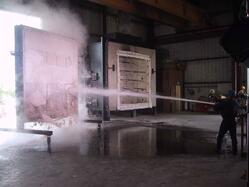 Last week’s dramatic fire in Edgewater, New Jersey, which resulted in the destruction of a large apartment complex, inevitably leads us to reflect again on the core principles of building for fire safety. What’s the best approach to protect both lives and property?
Last week’s dramatic fire in Edgewater, New Jersey, which resulted in the destruction of a large apartment complex, inevitably leads us to reflect again on the core principles of building for fire safety. What’s the best approach to protect both lives and property?
Most architects and engineers confront this challenge with three principles of balanced design in mind -- detection, suppression and containment. Detection is device-driven, ensuring that appropriate warning systems (such as smoke detectors) are used. Suppression depends on a reliable water supply and the maintenance of a sprinkler system.
Both detection and suppression concerns are typically addressed in building codes. Containment, unfortunately, doesn’t always receive the attention it deserves. The important role that noncombustible materials like concrete and concrete masonry can play is often not well understood.
The compartmentation of a building floor plan using materials with a minimum two hour fire rating for fire separation walls is clearly the best option. Preserving the integrity of the building for a longer period gives occupants time to escape, and also allows for safe areas of refuge if paths of egress are smoke-filled or blocked. Importantly, this also provides improved safety for firefighters who can trust that walls and floors won’t immediately collapse.
Edgewater Volunteer Fire Chief Thomas Jacobson said of the fire, “If [the building] was made out of concrete and cinderblock we wouldn’t have this problem but it’s lightweight construction. It's wood construction and this is what New Jersey code is.”
For additional information on fire safety go here and for an explanation on fire ratings go here and here.
